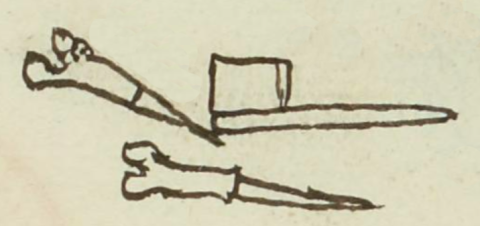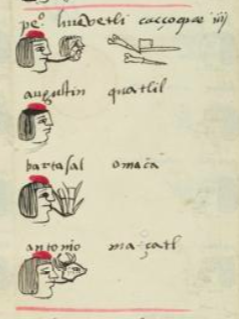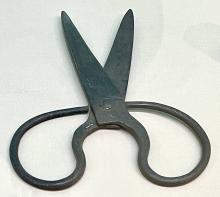caczoqui (MH593v)
This black-line drawing of the compound glyph for the occupation caczoqui (“shoemaker,” attested here as a man’s job) shows a shoe or sandal (cactli) facing right. Behind and below the shoe are two pairs of scissors or puncturing tools, pointing to the cutting or sewing (zozo) part of the job. The reduplication of that implied verb may explain why there are two pair of scissors.
Stephanie Wood
The need for two tools may be suggest "zozo" (to sew) or it may refer to the plural of the term, shoemakers. The gloss refers to a group of three shoemakers (caczoque), but just one is caczoqui.
Stephanie Wood
cacçoque iiii
nahui caczoque
Stephanie Wood
1560
Jeff Haskett-Wood
shoes, sandals, zapatos, sandalias, oficios, occupations, scissors, tijeras
These seventeenth-century forged iron scissors are in the museum of the city of Guadalajara. They measure 30 by 19 centimeters. The handles are much larger than the ones in the glyph above (if scissors are indeed what are shown next to the shoe). Photo by S. Wood, 15 April 2025.

caczoqui, shoemaker, https://nahuatl.wired-humanities.org/content/caczoqui
cac(tli), shoe or sandal, https://nahuatl.wired-humanities.org/content/cactli
zozo, to string things together, sew, https://nahuatl.wired-humanities.org/content/zozo
-qui, one who, https://nahuatl.wired-humanities.org/content/qui-1
zapatero
Stephanie Wood
Matrícula de Huexotzinco, folio 593v, https://www.loc.gov/resource/gdcwdl.wdl_15282/?sp=266&st=image
This manuscript is hosted by the Library of Congress and the World Digital Library; used here with the Creative Commons, “Attribution-NonCommercial-ShareAlike 3.0 License” (CC-BY-NC-SAq 3.0).





